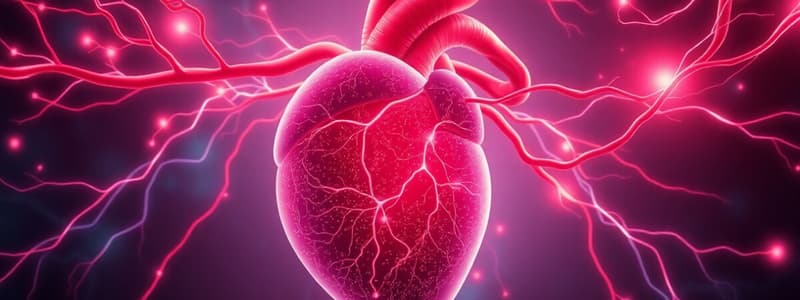Podcast
Questions and Answers
What directly determines mean arterial pressure (MAP)?
What directly determines mean arterial pressure (MAP)?
- Total blood volume and heart rate
- Cardiac output and total peripheral resistance (correct)
- Capillary filtration rate and stroke volume
- Arterial oxygen levels and venous return
Which process describes the local control of blood flow when tissue metabolism increases?
Which process describes the local control of blood flow when tissue metabolism increases?
- Passive hyperemia
- Static flow regulation
- Decentralized hyperemia
- Active hyperemia (correct)
Which statement accurately describes the effect of sympathetic stimulation?
Which statement accurately describes the effect of sympathetic stimulation?
- It lowers total peripheral resistance and mean arterial pressure.
- It causes vasodilation and increases cardiac output.
- It promotes vasoconstriction and increases total peripheral resistance. (correct)
- It enhances baroreceptor sensitivity to low blood pressure.
What is the effect of nitric oxide on vascular tone?
What is the effect of nitric oxide on vascular tone?
What mechanism allows baroreceptors to regulate blood pressure?
What mechanism allows baroreceptors to regulate blood pressure?
Which condition would lead to reactive hyperemia?
Which condition would lead to reactive hyperemia?
Which of the following is NOT a local vasodilator?
Which of the following is NOT a local vasodilator?
How does total peripheral resistance (TPR) impact mean arterial pressure (MAP)?
How does total peripheral resistance (TPR) impact mean arterial pressure (MAP)?
Flashcards are hidden until you start studying
Study Notes
Main Goal of Cardiovascular System
- Maintain mean arterial pressure (MAP), influenced by cardiac output (CO) and total peripheral resistance (TPR).
- CO is a product of stroke volume and heart rate.
Arterioles Function
- Regulate blood pressure by adjusting resistance levels.
- Constriction increases resistance, reduces downstream flow, and raises upstream pressure, impacting MAP.
- Dilation decreases resistance, enhances downstream flow, and lowers upstream pressure.
Total Peripheral Resistance (TPR)
- Represents the cumulative resistance from all arterioles.
- Directly correlates with MAP; higher TPR equates to a higher MAP.
Local Control of Blood Flow
- Flow auto-regulation occurs as tissues adjust blood flow based on metabolic needs.
- Low flow results in decreased oxygen and increased CO2, prompting arterioles to dilate.
- Active hyperemia occurs during increased metabolic activity (e.g., during muscle exertion), resulting in heightened blood flow.
- Reactive hyperemia is seen after occlusion, leading to increased blood flow once the obstruction is removed.
Central Control Mechanisms
- Baroreceptors located in the aortic arch and carotid bifurcation detect changes in MAP.
- Elevated MAP leads to increased firing of baroreceptors, which reduces sympathetic tone and induces vasodilation.
- Lower sympathetic tone results in decreased TPR and a subsequent drop in MAP.
Sympathetic vs Parasympathetic Effects
- Sympathetic activation, particularly via epinephrine, causes vasoconstriction, raising TPR and MAP.
- Parasympathetic activity, mediated by the vagus nerve, lowers heart rate and CO, contributing to decreased MAP.
Hormonal Regulation
- Angiotensin II and anti-diuretic hormone (ADH) act as vasoconstrictors, elevating TPR and blood pressure.
- Nitric oxide serves as a vasodilator, resulting in decreased TPR and MAP.
Summary of Local Vasodilators
- Factors triggering vasodilation include reduced oxygen, increased CO2, potassium, and adenosine derived from ATP breakdown.
- These signals aim to enhance blood flow to tissues in need.
Possible Test Concepts
- Importance of arterioles in controlling MAP.
- Understanding TPR mechanisms and their relation to blood pressure regulation.
- Differences in local and central blood flow control, including baroreceptor reflex mechanisms.
- Impacts of sympathetic and parasympathetic activation on vascular tone.
- Key hormonal regulators involved in vasoconstriction and vasodilation.
Studying That Suits You
Use AI to generate personalized quizzes and flashcards to suit your learning preferences.



